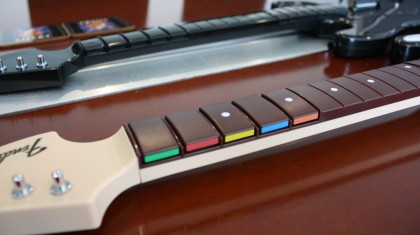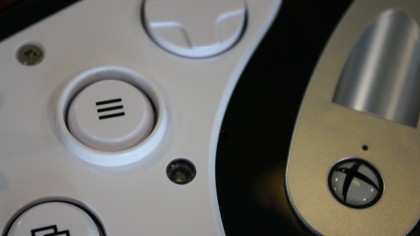Rock Band 4's instruments won't reinvent the wheel, but they're darn cool

It's happening. After five years of dead air, Harmonix has recently revealed that Rock Band 4 is a real game and, better, that it's coming to Xbox One and PS4 this year.
And while in the past, a new game in the music genre meant buying a full new set of instruments, this time it doesn't.
"In fact," says Alex Verrey, head of global PR and communications director at Mad Catz (the company making the controllers for the new game), "you can use the same instruments from previous games or any of your kit from the Guitar Hero series."
"I can't promise Rock Band 4 will work with the new Guitar Hero Live instruments, but we'll try and make that happen too," Verrey said.
But doing this, he tells me, means missing out on the slew of upgrades the team at Mad Catz has been working on over the past year.
Everything from the neck of the guitar to the reactiveness of the drum kit is getting a makeover. And while you could go back to using the same equipment from the last generation, Verrey says the new series of guitars, microphones and drum kits make a compelling case to step up to the new plastic when the game comes out later this year.

Verrey started my demo with the neck of the guitar and the instantly recognizable five fret buttons. They're noticeably firmer than before and have ridges between the frets to help axe-men and women find their fingering more easily.
Sign up for breaking news, reviews, opinion, top tech deals, and more.
In the past, shaking the controller resulted in the buttons rattling back and forth in their enclosure. This time? They didn't budge. The firmness and rigidity of the frets are reminiscent of Guitar Hero's better guitar design, hinting that Mad Catz has done its homework on what worked well in the past.

Moving down from the five fret buttons, the bridge of the guitar – while not as stylish as the The Beatles: Rock Band controller – felt firmer.
"That's because there's more plastic around the body and bridge," said Dalin Cienfuegos, Regional Marketing Manager at Mad Catz. "Try twisting the neck of the guitar. We've doubled down on the build quality of the guitar."
And, twist as I might, the neck didn't give.

That played into Verrey and Cienfuegos's next point: the overall body of the controller is stronger and more resistant to cracking, thanks to the reinforced design.
"Inside the body [of the guitar] we've doubled the amount of plastic 'ribbing' so this has more plastic in there holding this together," Cienfuego said.
This change, while noticeable, isn't necessarily as impactful for casual players as it is for veteran electronic virtuosos, but the demonstration was an effective one.

Notice the small translucent sensor near the share button? Rock Band 3 owners will remember that this inconspicuous, light-detecting camera is used in combination with a built-in mic to calibrate the controller to different A/V setups.
For Rock Band 4, the team at Mad Catz revisited the calibration tools, making them smarter and more precise than in games past.
"Another problem with the older Rock Band controllers was that when you needed to activate Overdrive, sometimes the guitar wouldn't register that it was upright. You would lose notes. You would drop notes. It would be incredibly frustrating," Verrey said.
"That's why, for this version of the controller, we've switched to a state-of-the-art digital sensor for Rock Band 4. It's much more accurate to a power of 100. It won't get stuck. It will work 100% of the time."

Nick Pino is Managing Editor, TV and AV for TechRadar's sister site, Tom's Guide. Previously, he was the Senior Editor of Home Entertainment at TechRadar, covering TVs, headphones, speakers, video games, VR and streaming devices. He's also written for GamesRadar+, Official Xbox Magazine, PC Gamer and other outlets over the last decade, and he has a degree in computer science he's not using if anyone wants it.